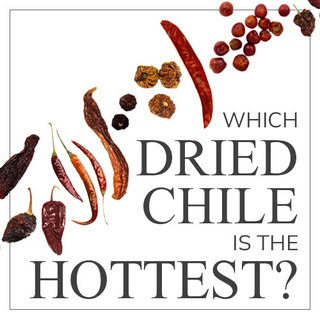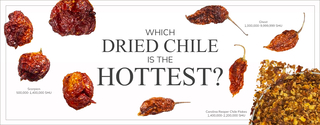Which Dried Chile Is the Hottest

Which Dried Chile Is the Hottest
The Carolina Reaper, at between 1,400,000 and 2,200,000 SHU (Scoville Heat Units), is the world’s hottest dried chile pepper and in November 2013 the Guinness Book of World Records recognized it as such. The previous record holder was the Trinidad Scorpion Chile at a little over 2,000,000 SHU which can also be found dried. Number three on the list is the dried Naga Viper chile (between 1,000,000 - 1,349,000 SHU) followed by the Ghost Chile a.k.a. Bhut Jolokia (a little over 1,000,000 SHU). The Dragon’s Breath chile, which clocks in with an astounding heat score of 2.4 million SHU, is hotter but was developed for use as an anesthetic and is too hot for human consumption and so is never found in a dried form.
It is estimated that there are approximately 50,000 chile pepper varieties in the world, and chile heat levels range from “sweet and mild” to “burn your face off” hot. The ubiquitous Bell Pepper, Capsicum annuum, is the mildest dried chile as it tips the Scoville Heat Scale at 0 SHU. Bell peppers, and all Capsicums, are members of the nightshade family.
The Carolina Reaper was bred by chile cultivator Ed Currie and is a hybrid chile pepper of the Capsicum chinense species. During its early cultivation it was referred to as simply "HP22B". The "HP22B" stands for "Higher Power, Pot no 22, plant B". As of 2013 it was over 7 generations old. This chile variety was created by crossing a Pakistani Naga with a Red Habanero type from St. Vincent’s Island in the West Indies.
Table of Contents
The Science Behind Who Likes Hotter Chiles
A recent study published in Current Research in Food Science1 found a strong interrelationship between "sensation-seeking" and the practice of chile eating. Researchers have identified several links between personality characteristics and our sensitivity to, and preferences for, basic flavors such as bitter, salty, sour, sweet, and the savory fifth taste, umami. Some individuals, especially in the West, gravitate to the fiery heat of chile peppers, and this has been linked to their personality. There are several neuroscience-based explanations for why there is likely to be a link between personality and taste/flavor preferences. The researchers stress that the connection has more to do with the taste-buds and the mouthfeel elements of tasting food (i.e., the burn of chile pepper) than with the olfactory contributions to flavor.
What Happens When You Bite into a Hot Pepper
Dr. Paul Bosland was a Regents Professor of Horticulture at New Mexico State University. Dr. Boslund retired after a 33 year career, which included co-founding the university’s nonprofit Chile Pepper Institute, where he ran NMSU’s chile breeding and genetics research program. He tells us that when someone eats an exceptionally spicy pepper, the first sensation is usually mouth numbness. "What's happening is that your receptors in your mouth are sending a signal to your brain that there's pain, and it's in the form of hotness or heat, and so your brain produces endorphins to block that pain."2.
Some of the hottest peppers also tend to produce a delayed heat response. “That’s why they’re perceived even hotter than they are,” Dr. Bosland says. “Because you take a bite, you don’t think it’s so hot, and you take that second bite. Now that first bite delayed heat comes on. And then the second one. It’s there and you’re over the top. You’re just over the top. It builds and builds and builds.”
Generally, the smaller the pepper, the hotter the pepper. There is a biological reason for that. In most peppers, the heat, which comes from the chemical compound capsaicin, is found only in what’s called the cross walls or placenta, where the seeds are attached. These are also called the ribs of a pepper. The walls of the fruit do not produce capsaicin, so a bigger fruit has more flesh across which it can dilute capsaicin, while a small fruit has concentrated capsaicin3.
References
1 Spence, C. (2022). What is the link between personality and food behavior? Current Research in Food Science, 5, 19–27.
2 Geggel, L. (2017, May 19). Superhot “Dragon’s Breath” Chili Pepper Can Kill. Here’s How. Livescience.Com. Retrieved May 21, 2022.
3 All About Chile Peppers | Good to Know & How to Grow (2022, March 11). Joe Gardener® | Organic Gardening Like a Pro. Retrieved May 21, 2022.

